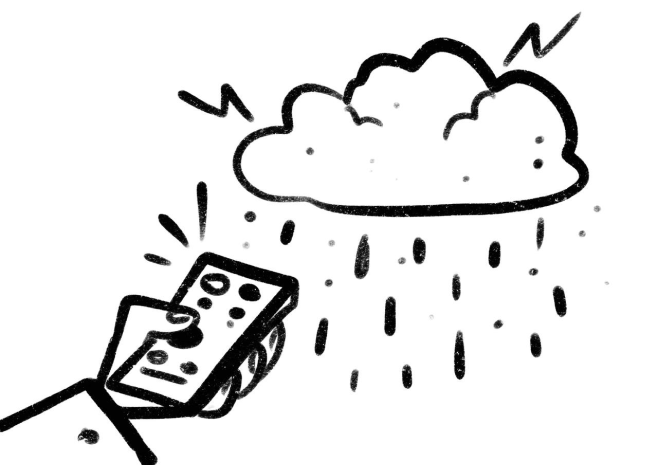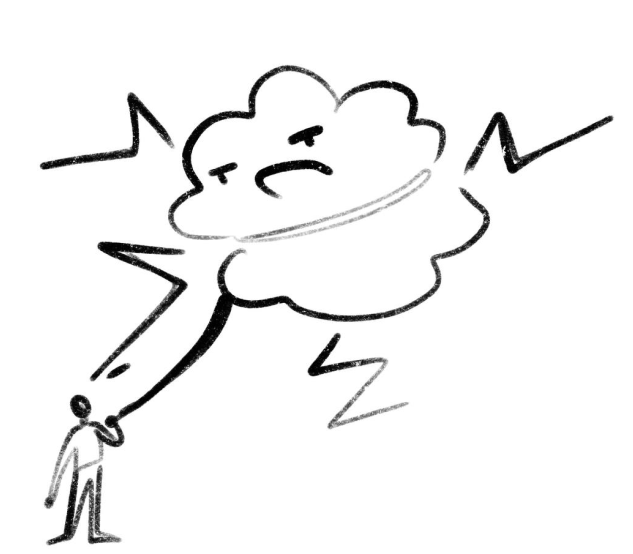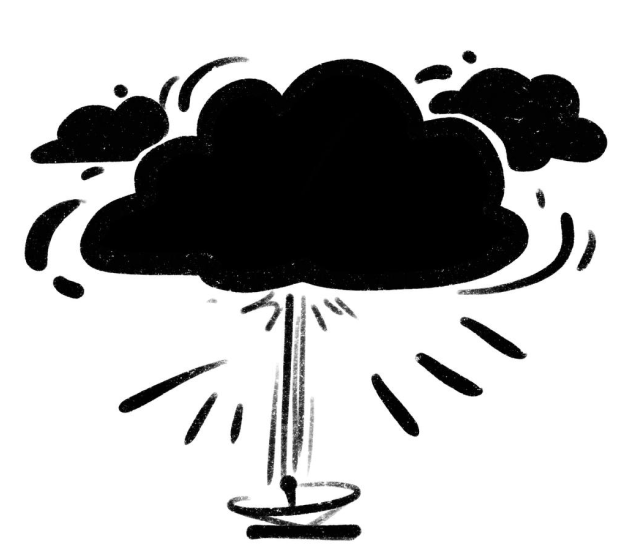Under the climate target: unveiling climate weapons
“…And the fountains of the great deep were broken up, and the windows of heaven were opened; and rain fell upon the earth forty days and forty nights.”
From the Old Testament (Genesis, Chapter 7, Verses 11-12)
Humanity craves to find the holy grail of destructive power — a new, extraordinary weapon capable of shocking even the most seasoned adversaries. Among the contenders in this gripping race for “powerful toys” stands the enigmatic geophysical weapon. It’s like a secret code scientists are trying to decipher: could it be possible to trigger earthquakes or unleash nature’s fury with unknown technologies? Hurricanes, torrential rains — what else?
Climate weapons are not mere fantasy; they symbolize a form of ultimate power that humanity has been speaking about since biblical times. The Bible contains no fewer than fifty examples where natural disasters serve as instruments of destiny: the righteous are saved, while the wicked face their punishment. The story of the Great Flood appears in various versions across almost all known religions.
As soon as people gain new knowledge or technology, they immediately consider its potential for warfare. Climate weapons tell the story of how the quest for power and control often crosses the boundaries of reason and morality.
A Serious Experiment Kit
…Imagine a powerful enemy force on the horizon, armed to the teeth and poised for attack. Suddenly, the sky tears open, unleashing a hurricane, followed by torrential rains. In mere moments, all preparations, supplies, and strategies are swept away by the fury of nature. Or perhaps an earthquake strikes without warning, plunging the opposing army into chaos and rendering it powerless before a single shot is fired. It’s every general’s dream: a scenario where the enemy destroys itself through sheer environmental catastrophe.

The concept of geophysical weaponry has been lingering in the air for over a century. While its actual existence remains speculative, cloaked in the fog of scientific conjecture, the idea is as tantalizing as it is terrifying. To control the weather would mean gaining an unparalleled advantage — the ability to unleash endless snowstorms, torrential downpours, or even tornadoes upon adversaries. In this vision, nature transforms from a mere ally to a cunning accomplice, capable of sowing disorder and destruction with precision. But can the dream of manipulating the weather truly become a reality? The question remains as open as the skies above.
Scientists tread lightly when it comes to the topic of climate weaponry. The fragility of a scientific reputation can rival that of a crystal vase — one careless touch, and it shatters into irreparable pieces. Therefore, discussions about climate weapons often occur behind closed doors, with researchers behaving more like secret agents from a James Bond movie than public figures.
Should humanity ever decide to alter the climate on a grand scale, it could result in something akin to a nuclear disaster — an outcome no rational mind would consider desirable. Thus, some argue it’s more appropriate to speak of “weather weapons” rather than “climate weapons.” However, the term “climate weapons” has already gained traction, becoming ingrained in popular consciousness and academic discourse alike.
Tesla Lights Up the Sky
Let us journey back to an era when Nikola Tesla’s ingenious ideas not only hoisted the sails of science but also challenged the very fabric of reality. This visionary mind deduced that the climate could be “tuned” by manipulating the ionosphere. If one could artificially influence this atmospheric layer, it might be possible to alter global weather patterns and even affect the lower layers of the atmosphere. This wasn’t a mere scientific trick but a potential revolution in physics.

Tesla’s experiments bordered on the miraculous. He created artificial ball lightning and performed other inexplicable feats. Some even speculate that the enigmatic Tunguska event of 1908 bears traces of his experiments. Shortly before his death in 1943, Tesla made a cryptic declaration: he had found a way to set the sky ablaze.
Dubbed “Doctor Electricity,” Tesla dreamed of constructing an invisible dome to shield nations from hostile aircraft, as well as developing laser and “electronic” weaponry. Indeed, Tesla was a figure who seemed capable of reshaping the very essence of the world.
At the dawn of the 20th century, on Long Island near New York City, Tesla erected a 50-meter-tall skeletal tower crowned with a massive copper plate. Within this structure lay a powerful transmitter, sunk 40 meters deep into the earth. This extraordinary apparatus enabled Tesla to generate artificial lightning and conduct astounding atmospheric experiments, leading to the discovery of a new physical principle he called the “resonance effect.”
Tesla’s atmospheric experiments did not mark the end of this story. Decades later, Bernard Eastlund expanded upon Tesla’s ideas to create the mysterious HAARP system, which some have labeled “America’s climate weapon.” Though the true nature of HAARP remains shrouded in secrecy, its existence has only added to the allure of Tesla’s pioneering concepts.
Theories surrounding the origins of climate technologies are plentiful, but one thing is certain: this field continues to captivate researchers, much like a lollipop tempts a child — with its blend of the otherworldly and the enigmatic.
Dancing with Drums
What if we look back to ancient times? Back then, armed with nothing but faith and creativity, people tried to control the whims of nature. They would gather in circles, don their brightest attire, and put on elaborate “weather shows.” Dancing under the sun, they hoped to sway the gods with their spirited moves, convincing them to shower the earth with rain.

If the sun was too relentless, they turned to specific rituals: burning herbs, singing chants, and offering sacrifices to soften the celestial forces. Even the Vikings, who bravely battled dragons by day, prayed to their gods by night, beseeching them to unleash thunderstorms on their foes. In other parts of the world, people would simply raise their hands to the sky and shout, “Hey, rain! Where are you? We’re waiting!”
In certain regions of Japan, a charming summer tradition persists: when the skies decide to bring the rainy season, locals craft adorable dolls meant to ward off the gloom. These quaint creations, called “teru-teru-bozu”, are made from simple materials but carry a deep cultural significance.
It’s fair to say our ancestors were true “weather magicians,” employing every tool at their disposal to negotiate with nature. And who knows? Perhaps their rituals weren’t as primitive as they might seem.
Miracle Tornado: A Weapon Not Fit for Superpowers
In the dark shadows of World War II, Nazi Germany sought to claim the status of a global superpower. The Third Reich’s engineers poured their efforts into discovering ways to harness the forces of nature as a lethal weapon. This ambition gave birth to the enigmatic “miracle gun,” a device purportedly capable of creating actual tornadoes.

The weapon’s power lay in its simple yet ingenious design: a long tube filled with combustible gas. Inside a special chamber, a turbine spun rapidly, and when the gas ignited, it was expelled with incredible force through a nozzle. This unleashed an uncontrolled natural phenomenon — a vortex that carried fiery tongues of destruction, turning everything in its path into chaos. Instead of using this natural fury to conquer the world, however, the Germans envisioned their climate-based weapon as a defensive tool for anti-aircraft purposes.
Predictably, the experiment failed. The tornadoes reached a height of just 300 meters before quickly dissipating, causing only minimal damage to high-altitude bombers. On the ground, however, the “miracle gun” was far more destructive, easily demolishing wooden houses and brick walls within a radius of 150–200 meters.
While the idea of directing tornadoes may sound like the stuff of science fiction, in practice, it proved to be a technological dead end — a stark reminder of the limits of human ambition when faced with the untamable power of nature.
The Weather’s Mood: Unpredictable, Even with Technology
“Eureka! We’ve discovered a way to activate powerful natural processes using just a drop of energy,” physicists declared one fine day. Indeed, why expend tons of resources when it’s possible to save and unleash natural mechanisms to do the work for us? The most enticing aspect of this idea lies in its efficiency: even a small intervention can trigger massive consequences.

Imagine unleashing the wind to wreak havoc on an enemy’s territory, inflicting enormous economic losses. Tempting, isn’t it? But then, logic steps in, as it often does in scientific endeavors: what happens if the hurricane suddenly changes direction? Like a mischievous cat, the wind could decide to choose a new master.
Dreaming of global catastrophes is one thing; attempting to control them is quite another. A “matchstick” is inherently fickle: it might set an enemy’s house ablaze, but it could just as easily surprise its creator by sparking a fire in their own backyard.
A Laboratory in the Sky
Welcome to a world where weather is no longer just nature’s whim, but a true playground for experiments! One of the most renowned methods of “tinkering with the heavens” is the technique of cloud seeding. The concept is simple: for rain to fall, tiny droplets of water need to combine into larger ones. However, while they remain small, the wind easily carries them higher, preventing them from reaching the ground. To help these droplets “grow,” special condensation nuclei — tiny “magnets” that attract water — are introduced. This is achieved by dispersing substances such as silver iodide into the clouds via aircraft.
For years, rumors swirled that during major events like holidays or Olympic games, clouds were “cleared out” to ensure fair skies. In reality, special chemicals were dispersed from planes to prevent rain from ruining the festivities. It sounds like modern magic.

Scientists have also ventured into experiments to “brighten” clouds, literally sprinkling the sky with sea salt to help clouds better reflect sunlight. But that’s not all! Bolder methods include injecting reflective sulfur compounds into the stratosphere to block a portion of solar radiation. However, these approaches are fraught with uncertainties: their effectiveness is still debated, and the risks and potential unintended consequences remain a mystery.
There are extraordinary examples of humanity rising to meet climatic challenges. Following the Chernobyl nuclear disaster, Soviet geoengineers demonstrated remarkable ingenuity by using special compounds to “trap” radioactive dust and prevent it from being carried away by the wind. To protect rivers, they even managed to create a kind of “rain shield” in the sky. This remarkable feat highlights how creativity and science can unite to safeguard our planet.
Americans Cook Up Spinach
It is a known fact that the U.S. military attempted to use atmospheric phenomena against their enemies at least once. During the Vietnam War, they created artificial rainfall to flood the infamous “Ho Chi Minh Trail,” a vital supply route through which the Viet Cong received aid from China.
Just as gourmets gather at a feast when summoned, clouds, under the influence of dispersed chemicals, began to gradually fill with water droplets, resulting in heavy rain. Over five years, American planes scattered around 5.4 thousand tons of silver iodide into the Vietnamese skies, aiming to flood farmlands and disrupt transportation. Rainfall in the region tripled compared to annual averages.
The technology itself was invented back in 1946, and by 1947, the U.S. government decided to use it to rid southern states of unwanted rains. However, instead of dispersing the clouds, the operation inadvertently created destructive tornadoes. The project was quickly abandoned — until it resurfaced during the Vietnam War.

“Operation Spinach” serves as a prime example of how science can be weaponized to alter the course of events. Despite their efforts, the Americans ultimately lost the war.
Electric Rivers
“Above our heads spins a truly magnificent electric machine!” declare the physicists as they step onto the stage once again. The Earth, like a mysterious giant, accumulates a negative charge. Meanwhile, we, its dutiful inhabitants, connect our household appliances to the planet to prevent them from “running amok.” The most efficient way to ground these devices? Bury a wire deep into the earth.
At the same time, about 100 kilometers above the oceans, the ionosphere, filled with positive charges, stretches across the sky. This “superlayer” is formed by cosmic forces—solar radiation and galactic energy.
Between the Earth and the ionosphere flows a staggering voltage of 400,000 volts, and actual rivers of current — up to 2,000 amperes — course around the planet. However, the harmony of this grand system is surprisingly delicate. Small disturbances in the air can disrupt this balance. Snow and rain, masters of their craft, collide particles, generating powerful static charges. Wind, like an agile acrobat, lifts microscopic dust into the air, adding even more complexity to this chaos orchestrated by nature.

But what if we could deliberately create artificial electric fields to summon snow, rain, or wind at will? This would be nothing short of scientific magic — an audacious leap into controlling the forces of nature. It’s a vision where physics dances with imagination, promising wonders that only science can unlock.
Ionospheric Monsters: Secrets of the Cosmic “Mirror”
Peering beyond the familiar leads us to the ionosphere — a kind of magical mirror that reflects radio waves far beyond our planet. Thanks to this cosmic layer, amateur radio operators can connect with people on the other side of the universe without spending a penny on roaming fees.
But here’s where the mysteries begin! In 1937, members of a rescue expedition reported a curious phenomenon: ships lost communication when they entered a fog bank. How is that possible? The ionosphere is located hundreds of kilometers above the Earth, while fog clings to the ground. It turns out that radio waves are remarkably sensitive to weather conditions. On a bright, sunny day, even basic radio receivers can catch signals from across Europe. But when fog descends or heavy rain falls, the connection vanishes into an invisible abyss.

Why does this happen? The answer lies in the nature of the ionosphere, an ocean of ions and electrically charged particles. When these particles are exposed to radiation, they begin to resonate, dancing in harmony with radio waves and creating a noisy cosmic symphony.
In their quest to manipulate the ionosphere, scientists developed specialized installations, with the enigmatic HAARP project in Alaska standing out as a prime example. By directing radio waves into this ionic “mirror,” researchers observe how the ionosphere reacts.
Could such experiments unlock the secrets of harnessing the ionosphere’s power? While the project remains shrouded in speculation, it continues to intrigue with its potential for groundbreaking discoveries — and possibly, for rewriting the rules of communication and weather control.
The Weapon of Armageddon
When comparing HAARP to other similar facilities, such as those in Tromsø or near Nizhny Novgorod, HAARP undoubtedly takes the crown. It’s the Large Hadron Collider of ionospheric research installations. Its antennas, towering at a majestic 30 meters, form 180 massive poles that resemble sentinels keeping watch over the sky. This imposing sight is both awe-inspiring and unnerving, steeped in myths and speculation.
HAARP captured public attention largely due to ominous rumors and sensationalized stories. It almost seems like a marketing strategy — the more whispers, the greater the intrigue. In speculative books by Nicholas Begich and Jeane Manning, HAARP is portrayed as a monstrous entity capable of manipulating weather patterns and even triggering artificial earthquakes.

“The installation functions as a reverse radio telescope — it doesn’t receive signals but emits them, with the capability to literally ‘boil’ the upper layers of the atmosphere,” claims one description. The disturbances caused in the ionosphere result in long-wave energy returning to Earth, passing through land, water, and even us. This technology is theorized to herald a new class of weaponry, with the potential to radically reshape modern warfare—a multi-purpose tool of destruction. Yet, errors in its operation could bring catastrophic consequences for the climate, as outlined in the book “HAARP: The Ultimate Weapon of the Conspiracy.”
One theory suggests that HAARP may have already harmed the United States itself. Proponents of this idea point to natural anomalies that plagued the country shortly after the system’s activation: a spike in tornadoes, an increase in insect die-offs, and other environmental disturbances.
If It’s Not Confirmed, It Doesn’t Mean It Doesn’t Exist
It comes as no surprise that nations categorically deny the existence of climate weapons. Their development was officially banned by the UN Convention on Environmental Modification Techniques (ENMOD) in 1977, initiated by the Soviet Union and supported by the United States.
However, significant catastrophes in Europe and worldwide seem to have increased after the HAARP facility was launched in 1997. A series of natural disasters followed, fueling speculation:
– 1997-1998: The “El Niño” hurricane devastated many cities, causing $20 billion in damage.
– 1999:A 7.6 magnitude earthquake struck Turkey, killing about 20,000 people.
– 2003: Hurricane Isabel was labeled one of the most powerful and deadly storms, claiming thousands of lives.
– 2004:A catastrophic earthquake near Sumatra, Indonesia, triggered a 9.0 magnitude tsunami, resulting in nearly 300,000 fatalities.
– 2005: Pakistan experienced a 7.6 magnitude earthquake, the strongest ever recorded in South Asia.
– 2008: Chile’s Chaitén volcano, dormant for centuries, erupted unexpectedly.
– 2010: Venezuelan President Hugo Chávez accused the U.S. of causing earthquakes in Haiti and China. That same year, Iceland’s Eyjafjallajökull volcano erupted, paralyzing air travel across Europe.
– 2010: A massive cyclone led to weeks of extreme heat in Central Europe, drawing hot air from the Mediterranean and Central Asia. Such cyclones were unprecedented in the region.
– 2012: A severe drought struck Iran, while catastrophic floods ravaged China, India, and Europe.
– In the U.S., Canada, and Russia, wildfires raged uncontrollably, while Brazil, known for its tropical warmth, experienced snow.
– In the Middle East, torrential rains poured in the scorching heat of 50°C across the UAE and Saudi Arabia.
Has nature gone mad?
Russia’s “Sura” Radio Complex, considered the sibling to HAARP, also conducts experiments on heating the upper atmosphere. Despite similar technological capabilities, scientists remain skeptical about its potential for military application. Officially, Sura is not deemed capable of creating extreme weather events, regardless of speculation.

While these systems might disrupt missile trajectories, satellites, and fighter jet electronics, they allegedly lack the power to generate droughts, torrential rains, hurricanes, or tsunamis. Such assertions form the “official version,” leaving room for further speculation.
The Tromsø Station Under Suspicion
In 1985, the world witnessed a groundbreaking discovery when researcher Bernard Eastlund introduced the “Method and Apparatus for Altering a Region in the Earth’s Atmosphere, Ionosphere, and Magnetosphere.” The principle was as simple as crafting the perfect cocktail: heat a small region of the ionosphere, and as it warms, a sudden surge of electric current could be triggered in the atmosphere.
Imagine this: as clouds gather and fill with rain, a small majestic window opens in the sky. Suddenly — bam! — streams of warm air rush toward this gap, creating a powerful anticyclone that begins to spin and expand like a giant vortex. Around the edges of this atmospheric beast, rain and snow rage, while its core is hot and dry. In mere moments, man-made weather is born!

Recently, the EISCAT facility in Tromsø, Norway, has found itself at the center of weather manipulation theories. In theory, this station can “pierce” the ionosphere over Eastern Russia and even extend its influence as far as the sunny Black Sea — all with just a slight adjustment to the angle of its antennas. This is its key feature: the ability to affect distant regions. Tromsø has even been accused of causing the 2010 drought in Russia.
Scientists observed peculiar behavior in the ionosphere during this time, noting that it seemed to shift into an anomalous winter-like state — in the middle of summer. Was this a natural phenomenon? An artificial manipulation? Or completely unrelated? This mystery remains unsolved. Russian researchers suspect foul play, while U.S. scientists stay silent.
While discussions around climate weapons swirl on one continent, across the Atlantic under the warm American sun, some Katrina theorists argue that this devastating hurricane could not have formed naturally. Instead, they claim it was the result of deliberate interference. Behind the devastation, they suspect, lies the hidden hand of an adversary. The debate is far from over.
A “Weather Lab for Dummies”
For many years, scientists, military strategists, and policymakers across the globe have experimented with taming weather to serve their ambitions. The outcomes of these efforts have been varied, ranging from limited success to outright failure.
Deep within Soviet laboratories, researchers developed an extraordinary and ominous device: the lithospheric resonator — a machine with the potential to trigger apocalyptic events. This enigmatic technology was designed to be installed in hidden tunnels beneath the Kuril Islands as a last-resort weapon. In the event of escalating international tensions, the resonator could theoretically ignite a chain reaction of earthquakes across the Pacific Ring of Fire, transforming the tranquil ocean into a raging cauldron of chaos.

The first test run occurred in the Caucasus, and though shrouded in secrecy, it is speculated that the device may have contributed to a series of earthquakes in the Soviet Union. This concept — equal parts scientific endeavor and dystopian fantasy — could easily serve as the basis for a gripping film about ancient secrets and futuristic technology.
Creating wind on demand is no easy feat. To produce the desired effect, scientists must heat a large volume of air to initiate movement when it encounters cooler masses. By calculating the heat capacity of air, one can estimate the energy required to raise its temperature to the necessary level.
However, the catch is in the sheer energy demands such an operation would entail. To unleash the force of a powerful climate weapon, one would need staggering amounts of energy — not just for heating but also for ensuring its efficient delivery from the heat source to the air mass. Without this precision, the entire plan would falter, leaving resources squandered and efforts in vain.
To Cool Down, Cool Off with Bacteria
As our planet continues to swelter under the relentless heat of the sun, geoengineering is stepping up with bold innovations to tackle climate challenges. Researchers are developing groundbreaking devices to extract greenhouse gases from the atmosphere and are even enlisting tiny microorganisms to take on this monumental task. While working with microscopic helpers like plankton might seem far less radical than deploying a colossal space sunshade to block solar rays, it’s proving to be a promising path forward.
At the forefront of this effort is Mary Lidstrom, a distinguished professor of chemical engineering and microbiology at the University of Washington. Her groundbreaking research focuses on genetically modifying bacteria to transform them into climate-saving agents. Among these remarkable microorganisms are methanotrophs, which naturally feed on methane, one of the most potent greenhouse gases. These microbes are already helping reduce methane levels, but Lidstrom’s ambitions go further: she aims to engineer them to extract even more methane from the atmosphere.

To harness the full potential of these microbial champions, researchers are designing advanced bioreactors. Within these bioreactors, the modified bacteria will feast on atmospheric methane, turning it into harmless byproducts and contributing to a more stable and sustainable climate.
What if…
A world where climate weaponry is a tangible tool of power paints a grim picture. Would it be unleashed against adversaries in a conventional sense? More likely, it would become another “means of leverage”, akin to nuclear arsenals today — deterring conflict by its very existence. Acknowledging this potential, leading nations might rush to develop their own climate-altering technologies, fearing the prospect of being defenseless against such a threat.
Humanity continues to grapple with finding equilibrium, striving to coexist with the awesome forces of nature that still hold the power to threaten our survival. While brilliant ideas and bold dreams of TV-style weather control remain far-fetched, they highlight our yearning to tame and understand nature’s mysteries. For now, the prospect of humans becoming true sculptors of the atmosphere remains in the realm of distant possibility.

In the meantime, discussions about climate weaponry feel like old ghost stories — occasionally dusted off to scare the public. Yet, as with all such tales, there’s often a kernel of truth buried within. While the reality of such technology may be decades or centuries away, the thought of harnessing or weaponizing the climate forces us to reflect on how far humanity is willing to go in its quest for dominance and security — and at what cost.
We’ve ventured beyond the boundaries of time and space. By the way, it’s empty there.
Thank you!




